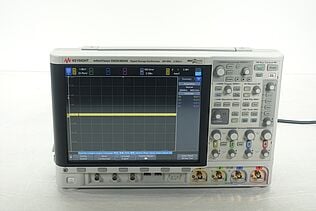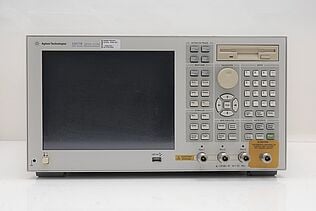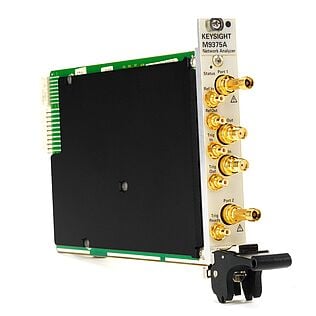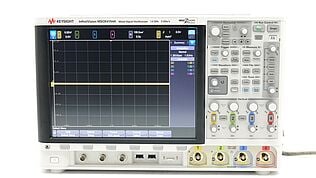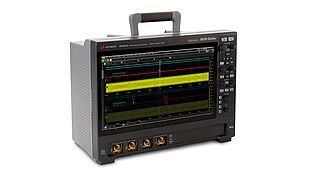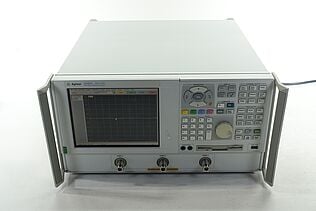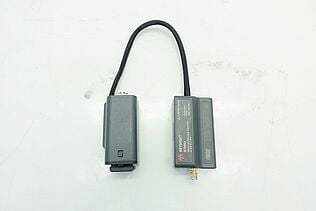- Introduction
- What is Ohm’s Law?
- Ohm’s Law Formula
- The Importance of Ohm’s Law in Electrical Engineering
- Key Applications in Electrical Engineering
- How to Use an Ohm’s Law Calculator
- Tips for Accurate Calculations
- Ohm’s Law: Practical Examples
- Advanced Applications of Ohm’s Law
- Key Advanced Applications
- Series vs. Parallel Circuits
- Troubleshooting and Common Mistakes
- Common Issues and Solutions
- Instrumentation and Measurement Accuracy
- Key Measurement Instruments
- Importance of Precision and Quality
- Calibration, Maintenance, and Environmental Factors
- Enhance Your Engineering Precision with Keysight's Certified Equipment
- Conclusion: Empower Your Electrical Calculations Today
- Whenever You’re Ready, Here Are 5 Ways We Can Help You
Welcome to our Ohm’s Law Calculator, where we're dedicated to making your electrical engineering and physics calculations both faster and more accurate.
We understand the importance of having reliable tools that don't compromise on precision. Our Ohm’s Law Calculator is the ideal solution for anyone looking to streamline their workflow while ensuring every calculation is spot-on.
This tool is not just about speed; it's about empowering you to achieve better results with less effort, so you can focus more on innovation and less on the numbers.
What is Ohm’s Law?
Ohm’s Law is a cornerstone principle in the fields of electrical engineering and physics, articulating the fundamental relationship among voltage, current, and resistance within an electrical circuit.
This law assumes that the current flowing through a conductor between two points is directly proportional to the voltage across the two points, inversely proportional to the resistance between them.
The historical roots of Ohm’s Law trace back to the early 19th century when German physicist Georg Simon Ohm embarked on his groundbreaking research. His work laid the foundational framework for understanding and analyzing electrical circuits, profoundly influencing the development of modern electrical engineering and physics.
Ohm’s contributions have not only provided us with a fundamental law but have also inspired countless innovations and applications in the electrical domain.

Ohm’s Law Formula
Ohm's Law is elegantly simple yet profoundly impactful in understanding the relationship between voltage, current, and resistance.
The formula is expressed as: V=IxR where:
- V represents the voltage in volts (V)
- I signifies the current in amperes (A)
- R denotes the resistance in ohms (Ω)
Let's break down the formula to understand how each component influences the others:
- Voltage (V): The electric potential difference between two points in a circuit. It's the driving force that pushes the current through the circuit. Increasing the voltage will increase the current if the resistance remains constant.
- Current (I): The flow of electric charge through the circuit, measured in amperes. The current is directly proportional to the voltage; higher voltage results in a higher current, assuming resistance doesn't change.
- Resistance (R): The property of a material to resist the flow of current, measured in ohms. Resistance inversely affects the current; higher resistance leads to lower current for a given voltage.
Understanding the interplay of these components allows for precise control and analysis of electrical circuits, making Ohm’s Law a cornerstone in the field of electrical engineering.
The Importance of Ohm’s Law in Electrical Engineering
Ohm’s Law is not just a foundational principle in electrical engineering; it's an essential tool for anyone involved in the design, analysis, and troubleshooting of electrical circuits.
Its simplicity and universality make it indispensable in a variety of applications, from the most basic to the most complex systems.Engineers can confidently predict circuit behavior, optimize performance, and guarantee safety through a thorough understanding and application of Ohm's Law.
Key Applications in Electrical Engineering
- Calculating power consumption: Ohm’s Law is crucial for determining the power consumption of electrical devices. By knowing the voltage across a device and the current flowing through it, engineers can calculate power using the formula P=V×I, which is derived from Ohm’s Law. This calculation is fundamental in designing energy-efficient devices and systems.
- Designing circuits: Whether designing a simple circuit for a classroom project or a complex system for industrial applications, engineers rely on Ohm’s Law to determine the necessary values of voltage, current, and resistance. It helps in selecting the right components, such as resistors, to achieve desired circuit behavior.
- Safety considerations: Ohm’s Law plays a vital role in ensuring the safety of electrical systems. By calculating the expected current flow, engineers can choose appropriate wire sizes and circuit breakers to prevent overheating and fire hazards. It also aids in the design of grounding systems to protect against electric shock.
- Troubleshooting and maintenance: When electrical systems fail or perform suboptimally, Ohm’s Law is a first-line tool in diagnosing problems. By measuring voltage and resistance, technicians can identify issues like short circuits, open circuits, and components that are out of specification.
- Voltage and current regulation: In power distribution and electronic devices, maintaining stable voltage and current levels is crucial. Ohm’s Law underpins the design of regulators and stabilizers that keep these parameters within safe and functional ranges.
- Signal analysis: In communication systems, Ohm’s Law helps in analyzing signal transmission over different mediums. It aids in understanding the impedance of cables and designing circuits for optimal signal clarity and strength.
The broad applicability of Ohm’s Law across various facets of electrical engineering underscores its importance. From the initial stages of conceptual design to the final stages of product testing and maintenance, Ohm’s Law provides the theoretical and practical foundation needed to navigate the complexities of electrical systems.
How to Use an Ohm’s Law Calculator
Using an Ohm's Law Calculator simplifies the process of solving for any unknown variable in an electrical circuit, whether it's voltage (V), current (I), or resistance (R).
Here's a quick guide on how to use the calculator effectively:
1. Identify the known variables: Determine which two variables you know among voltage, current, and resistance. These could be any two of the following:.
- Voltage (V) in volts
- Current (I) in amperes
- Resistance (R) in ohms
2. Select the unknown variable: Decide which variable you need to solve for. This will be the variable you don't have the values for.
3. Input the known variables: Enter the values of the two known variables into the calculator. Make sure to input them in the correct fields designated for voltage (V), current (I), or resistance (R).
4. Solve for the unknown: Once you've inputted the known values, the calculator will automatically compute the unknown variable using Ohm’s Law. For instance, if you know the current and the resistance, the calculator will solve for the voltage by applying the formula V=I×R.
5. Review the result: The calculated value of the unknown variable will be displayed. Review the result to ensure it makes sense in the context of your project or problem.
6. Adjust values as needed: If you need to explore different scenarios or solve for different variables, adjust the known values accordingly and repeat the process.
This straightforward process allows you to quickly and accurately solve for any variable in an electrical circuit, facilitating efficient design, analysis, and troubleshooting.
Tips for Accurate Calculations
It's important to make sure your calculations are accurate when using Ohm's Law. Here are some practical tips to help you achieve precise results.
- Use correct units: Always convert your measurements to the standard units of Ohm’s Law: volts (V) for voltage, amperes (A) for current, and ohms (Ω) for resistance. For example, convert milliamps to amps (1 A = 1000 mA) before inputting values.
- Double-check input values: Verify the accuracy of your input values. Small errors in measurement can lead to significant discrepancies in the results.
- Cross-verify calculations: After using the calculator, manually check the results using the Ohm’s Law formula. This cross-verification can help catch any potential errors in calculation or input.
- Use alternative calculation methods: If possible, solve for the unknown variable using different methods or formulas related to electrical principles. This can serve as a confirmation of your results.
- Consider real-world factors: Remember that real-world conditions such as temperature and material properties can affect resistance. Factor these into your calculations for more accurate predictions.
By following these tips, you can enhance the reliability of your calculations and make more informed decisions in your electrical engineering projects.
Ohm’s Law: Practical Examples
Ohm’s Law finds application in numerous real-world scenarios. Here are a couple of examples illustrating its practical use.
Example 1: Calculating Required Resistance for a LED Light Circuit
- Scenario: You want to connect a LED light to a 12V battery. The LED requires 2V to operate and has a current rating of 20mA (0.02A).
- Objective: Calculate the required resistance to safely operate the LED.
Calculation
- Voltage across the resistor (VR) = Total Voltage – LED Voltage = 12V – 2V = 10V
- Current (I) = 20mA = 0.02A
- Resistance (R) = VR//I = 10V / 0.02A = 500Ω
- Using the calculator: Input 10V as the voltage and 0.02A as the current to solve for resistance. The calculator confirms a resistance of 500Ω.
Example 2: Determining the Appropriate Fuse for a Household Appliance
- Scenario: A household appliance operates at 240V and draws a current of 2A.
- Objective: Determine the minimum fuse rating to safely use with the appliance.
Calculation
Power (P) = Voltage (V) × Current (I) = 240V × 2A = 480W
Fuse rating should be slightly higher than the appliance's power consumption to allow for small surges, so a fuse with a rating of just above 480W (or 2A at 240V) would be appropriate.
Using the calculator
Though primarily for Ohm’s Law, understanding how the fuse rating correlates with the appliance's power consumption and current allows for informed decisions. The calculation here is straightforward, focusing on the appliance's current draw.
These examples demonstrate how Ohm’s Law assists in making critical decisions in electrical circuit design and safety, with the calculator serving as a quick and accurate computational aid.
Advanced Applications of Ohm’s Law
Ohm’s Law extends beyond basic calculations, playing a crucial role in more complex electrical engineering applications. Its integration with other principles allows for comprehensive analysis and design of electrical systems.
Key Advanced Applications
- Analysis of series and parallel circuits: Ohm’s Law is instrumental in calculating the total resistance, voltage drops, and current distribution in both series and parallel circuits.
- Power calculations: Using the formula P=IV (where P is power in watts), Ohm’s Law enables the calculation of power consumption in an electrical component or circuit.
- Integration with Kirchhoff's Laws: Ohm’s Law works hand in hand with Kirchhoff's Voltage Law (KVL) and Kirchhoff's Current Law (KCL) for analyzing complex circuits, ensuring the conservation of energy and charge.
Series vs. Parallel Circuits
| Feature | Series Circuits | Parallel Circuits |
|---|---|---|
| Current Flow | Identical through all components | Splits across branches |
| Voltage Distribution | Divides among components | Uniform across all components |
| Total Resistance | Increases with more components | Decreases with more components |
| Application | Used for simple control circuits | Common in home wiring and electronic devices |
This overview illustrates how Ohm’s Law is pivotal in navigating the complexities of electrical circuits, empowering engineers to design, analyze, and optimize for peak performance and safety.
Troubleshooting and Common Mistakes
When using the Ohm’s Law Calculator, users often encounter specific issues due to common mistakes. Recognizing and rectifying these mistakes is crucial for accurate calculations.
Here are some common mistakes and their solutions.
Common Issues and Solutions
| Common Mistakes | Impact | Solutions |
|---|---|---|
| Incorrect Units | Leads to incorrect calculations | Always convert to standard units (volts, amperes, ohms) before input. |
| Misinterpretation of Variables | Causes confusion between voltage, current, and resistance. | Review the basic principles of Ohm’s Law to understand how variables interact. |
| Rounding Errors | Results in less precise calculations. | Use exact values as much as possible and round off only in the final step. |
| Ignoring Circuit Complexity | Simplifies complex circuits inaccurately. | Break down complex circuits into simpler parts and apply Ohm’s Law to each part. |
By addressing these common mistakes with the suggested solutions, users can enhance their proficiency with the Ohm’s Law Calculator, leading to more reliable and accurate electrical calculations.
Instrumentation and Measurement Accuracy
Accurate applications of Ohm's Law rely heavily on the precision and quality of measurement instruments like multimeters, oscilloscopes and ohmmeters. These tools are indispensable for obtaining precise voltage, current, and resistance values, which are crucial for accurate calculations.
Key Measurement Instruments
- Multimeters: Versatile tools for measuring voltage, current, and resistance. Accurate readings provided by high-quality multimeters are essential for correctly applying Ohm's Law.
- Oscilloscopes: Essential for visualizing voltage over time, allowing for the analysis of current flow and voltage levels in dynamic systems.
- Ohmmeters: Specifically designed to measure resistance, ohmmeters are vital for directly applying Ohm’s Law, especially in troubleshooting and circuit design.
- Voltage Meters (Voltmeters): Used to measure voltage between two points in a circuit without altering the current flow, ensuring accurate voltage readings.
- Current Meters (Ammeters): Measure the flow of current through a circuit. Precision ammeters are crucial for applications where exact current measurements are necessary.
Importance of Precision and Quality
- Precision in measurements: Makes certain that the calculations based on Ohm’s Law are reliable, which is vital for both simple and complex electrical engineering applications.
- Accuracy of instruments: High-quality instruments minimize errors in measurement, leading to more dependable and consistent results.
- Understanding instrument specifications: Familiarity with the specifications and limitations of your tools allows for better decision-making in their application and ensures the validity of your measurements.
Investing in and properly maintaining high-quality measurement instruments underlines the importance of precision and accuracy in the practical application of Ohm’s Law.

"Customers come to us and buy used, because they get premium KS quality with a lower price, and we ship within 2 weeks. New equipment right now takes up to 14 weeks to ship." – Keysight Account Manager
Calibration, Maintenance, and Environmental Factors
For electrical measurement instruments to provide reliable results, regular calibration and maintenance are essential. These practices ensure that the instruments perform at their best, yielding accurate measurements crucial for applications of Ohm's Law and other electrical calculations.
Importance of Calibration and Maintenance
- Calibration: This process adjusts the precision and accuracy of measurement instruments, aligning them with established standards. Regular calibration is necessary to compensate for drifts and deviations that occur over time.
- Maintenance: Routine maintenance includes checking for wear and tear, replacing damaged parts, and updating software (for digital instruments). This prevents unexpected failures and inaccuracies in measurements.
Influence of Environmental Factors
Environmental conditions such as temperature, humidity, and electromagnetic interference can significantly affect the accuracy of electrical measurements.
To mitigate these effects, engineers should:
- Perform measurements in an environment where temperature and humidity are controlled or within the instrument's specified operating conditions.
- Use shielded cables and proper grounding techniques to minimize interference that could skew measurements.
- Store and use instruments in ways that protect them from dust, moisture, and other environmental hazards.
Enhance Your Engineering Precision with Keysight's Certified Equipment
Conclusion: Empower Your Electrical Calculations Today
Throughout this article, we've explored the fundamental importance of Ohm’s Law in electrical engineering and electronics.
From introducing the basic formula and its components to diving into practical applications and advanced uses, we've highlighted how this law serves as the backbone of electrical circuit analysis and design.
The significance of precise measurements, the necessity for regular calibration and maintenance of instruments, and the impact of environmental factors on accuracy have also been underscored.
Understanding and applying Ohm’s Law correctly is crucial for anyone looking to excel in electrical engineering or electronics. It enables the accurate calculation of voltage, current, and resistance, ensuring the safe and efficient operation of electrical circuits.
We encourage you to practice using an Ohm’s Law Calculator with a variety of examples to solidify your understanding and enhance your skills.
Remember, mastering Ohm's Law is not just about understanding the basics; it's about applying these principles to unlock new dimensions of electrical engineering excellence.
Empower your electrical calculations today and pave the way for innovation and success in your projects and research.
Whenever You’re Ready, Here Are 5 Ways We Can Help You
- Browse our Premium Used Network Analyzers, Oscilloscopes, Signal Analyzers and Waveform Generators
- Call tech support US: 1 800 829-4444 Press #, then 2. Hours: 7 am – 5 pm MT, Mon– Fri
- Talk to our sales support team by clicking the icon (bottom right corner) on every offer page.
- Create an account to get price alerts and access to exclusive waitlists
- Talk to your account manager about your specific needs.
































